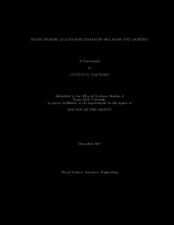| dc.description.abstract | This work investigates the use of shape memory alloys (SMAs) for vibration isolation
and damping of mechanical systems. The first part of this work evaluates the nonlinear
dynamics of a passive vibration isolation and damping (PVID) device through
numerical simulations and experimental correlations. The device, a mass connected
to a frame through two SMA wires, is subjected to a series of continuous acceleration
functions in the form of a sine sweep. Frequency responses and transmissibility of the
device as well as temperature variations of the SMA wires are analyzed for the case
where the SMA wires are pre-strained at 4.0% of their original length. Numerical
simulations of a one-degree of freedom (1-DOF) SMA oscillator are also conducted
to corroborate the experimental results. The configuration of the SMA oscillator is
based on the PVID device. A modified version of the constitutive model proposed
by Boyd and Lagoudas, which considers the thermomechanical coupling, is used to
predict the behavior of the SMA elements of the oscillator.
The second part of this work numerically investigates chaotic responses of a 1-
DOF SMA oscillator composed of a mass and a SMA element. The restitution force
of the oscillator is provided by an SMA element described by a rate-independent,
hysteretic, thermomechanical constitutive model. This model, which is a new version
of the model presented in the first part of this work, allows smooth transitions
between the austenitic and the martensitic phases. Chaotic responses of the SMA oscillator are evaluated through the estimation of the Lyapunov exponents. The Lyapunov
exponent estimation of the SMA system is done by adapting the algorithm
by Wolf and co-workers. The main issue of using this algorithm for nonlinear, rateindependent,
hysteretic systems is related to the procedure of linearization of the
equations of motion. The present work establishes a procedure of linearization that
allows the use of the classical algorithm. Two different modeling cases are considered
for isothermal and non-isothermal heat transfer conditions. The evaluation of
the Lyapunov exponents shows that the proposed procedure is capable of quantifying
chaos in rate-independent, hysteretic dynamical systems. | en |


